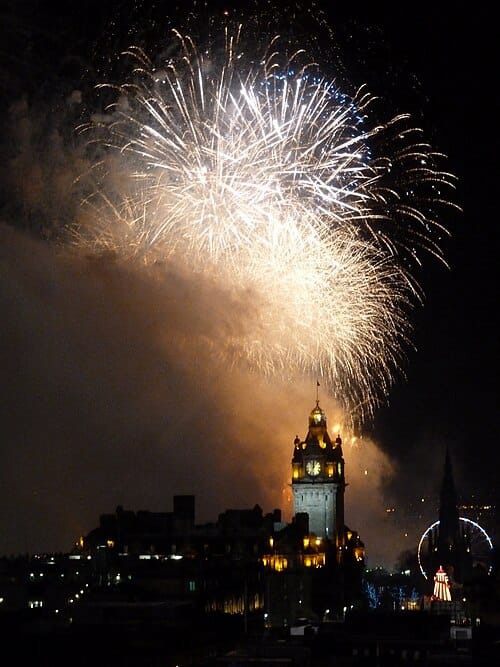hogmanay

Hogmanay is a Scots word for New Year’s Eve or for a gift given to someone, especially a child, at the new year. It is a borrowing from the French auguilanleu, which in turn is probably a variation on l’an neuf (the new year).
It is first recorded in an otherwise Latin record of gifts given at the order of Sir Robert Waterton in Methley, West Yorkshire for New Year’s 1443–44:
Et solutum xxxj die decembris magn. hagnonayse xijd. Et parv. Hagnonayse viijd. xxd.
Et solutum primo die mensis Januarij Pasy munstrallo ex precepto domini xijd. Et solutum iiij die mensis Januarij instrionibus Thome Haryngton ex precepto domini xxd.
(And paid on 31 December (for) a large hogmanay 12 pence, and (for) a small hogmanay 8 pence 20 pence.
And paid on 1 January to Pasy, a minstrel, by the lord’s command 12 pence. And paid on 4 January to the players of Thomas Haryngton, by the lord’s command, 20 pence.)
Hogmanay doesn’t appear again for some 150 years, making this relatively southern appearance of the word even more of an outlier. It seems likely, therefore, that the word was oral and colloquial use in the fifteenth and sixteenth centuries in both the north of England and in Scotland.
We next see the word in the court records of Elgin Scotland for 1604, when a certain William Patton was summoned for “singing hogmanay.” The Oxford English Dictionary places this use under the sense of a New Year’s gift, meaning that Patton was accused of asking for such a gift. Alternatively, he could have been celebrating hogmanay:
January 3rd.—Jonet Wulsoun and Meg Gadderar accusit for dancing on Sonday last befoir the Shereffis yet. William Pattoun delatit to haue been singand hagmonayis on Satirday and thairfoir to be summonit to Fryday nixt.
(3 January—Janet Wulsoun and Meg Gadderar are accused of dancing last Sunday before the sheriff’s gate. William Pattoun accused of having been singing hogmanay on Saturday, and therefore to be summoned next Friday.)
It clearly appears as a name for New Year’s Eve in a “Blasphemous & Treasonable Paper” published in 1681:
We renounce the names of Moneths, as January, February, March, April, May, June, July, August, September, October, Nov. December. Sunday, Monday, Tuesday, Wednesday, Thursday, Friday, Saturday, Martymass, Hol•••yes, for there is none holy but the Sabbath day. Lambas day, Whitsunday, Candlemass, Beltan, Crossstones, and Images Fairs, named by Saints, and all the remnants of Popery, Yool or Christmas, old wives Fables and By words, as Palmsunday, Carlinsunday, the 29. of May, being dedicat by this Generation to Prophanity, Peacesunday, Halloweven, Hogmynae night, Valenteins even; no Marrying in the Moneth they call May.
The entire pamphlet is one long list of “blasphemies” that the authors are rejecting. The authors claim to be in prison in London for their crimes, and this is supposed to be a confession. It’s clearly satire and not to be taken seriously, but the mention of hogmanay is legitimate evidence for our purposes here.
Sources:
Cramond, William. The Records of Elgin 1234–1800, vol. 2. Stephen Ree, ed. Aberdeen: University of Aberdeen, 1908, 119. HathiTrust Digital Library.
Ker, Walter, et al. A Blasphemous & Treasonable Paper, Emitted by the Phanatical Under-subscribers, on May 1, 1681, 3. University of Michigan Library. Google Books.
Oxford English Dictionary Online, November 2010, s.v. hogmanay, n.
Scottish National Dictionary, 2005, s.v. hogmanay, n. Dictionaries of the Scots Language | Dictionars of the Scots Leid.
Yarwood, R. E. “Hogmanay 1443 in West Yorkshire.” Folklore, 95.2, 1984, 252–254 at 253. JSTOR.
Photo credit: Gyula Péter, 2011. Wikimedia Commons. Licensed under a Creative Commons Attribution 3.0 Unported license.